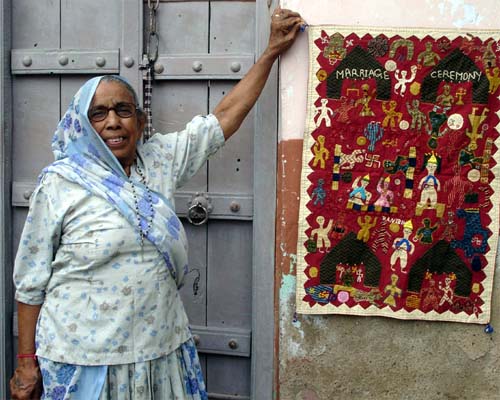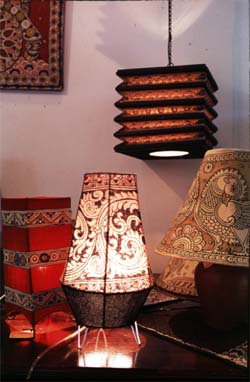Dec 10, 2025
Dec 10, 2025
The traditional arts and crafts of India enjoy wide appreciation for their intricacy and vibrancy. But the influx of a wide variety of international and designer labels has brought down the demand for traditional fabrics, resulting in loss of livelihood for weavers and artisans in different parts of the country. Things have gradually deteriorated for this skilled set, with most having to resort to becoming daily wage laborers and domestic servants to earn a living. Three women are now working tirelessly to energize artisans from different parts of the country and are helping them to create newer avenues of income generation. In the process, they are contributing to the restoration of India's vibrant artistic heritage. In the early 1970s, when Judy Frater, 56, arrived from the US to research Indian textiles, she met a female artisan in Kutch (Gujarat) who said, "Instead of studying us, why don't you help us?" Her remark triggered introspection. "I realized it was practical and better to involve artisans in the preservation of traditional crafts than mere documentation," Frater says. She stayed on, researched some more and then set upKala Raksha in Bhuj in 1991 with 20 to 25 artisans. Today, it has more than 600 artisans under its fold. Here they work with six hand embroidery styles - soof (the stitch is worked from the back of the fabric by When she tried to speak to the distraught weavers, they were suspicious. "They wanted to know why I was intruding into their lives, especially since no one had ever done so before." But the women in one village implored her to help them. When Prajapati probed as to the kind of help they expected, one of them spoke up in a quiet voice: "Give us any work that would enable us to earn Rs 10 (US$1=Rs40) per day." 
counting the weave and inserting the needle at regular intervals), khaarek(geometric style with an outline of black squares filled with satin stitching), paako
(a tight square chain and double buttonhole stitch), Rabari (the pattern is outlined by chain stitch and decorated with mirrors and accent stitches), Garasia Jat (cross stitch studded with minute mirrors) and Mutava (fine and geometric, it combines a variety of local styles). In 2005, Frater also opened a design school for artisans to educate them on the finer aspects of application of design. The sole criterion for enrolment is the knowledge of at least one form of traditional craft.
 Anita Reddy, 52, decided to work for the revival of kalamakari (a method of painting natural dyes onto cotton or silk fabric with a bamboo pen or 'kalam') when she saw aged artisans walking the streets of Bangalore trying to sell their exquisite fabrics. She conferred with one such artisan and made plans to visit his village, Sri Kalahasti, in Andhra Pradesh. When Reddy arrived, she found young women eager to utilize their artistic skills to help contribute monetarily to their families. "All of them wanted to lift their families from the drudgery of debt and poverty," she recalls. Eight years ago, she started Dwaraka to provide existing and new artisans a platform through which they could sell their beautiful pieces of traditional art.
Anita Reddy, 52, decided to work for the revival of kalamakari (a method of painting natural dyes onto cotton or silk fabric with a bamboo pen or 'kalam') when she saw aged artisans walking the streets of Bangalore trying to sell their exquisite fabrics. She conferred with one such artisan and made plans to visit his village, Sri Kalahasti, in Andhra Pradesh. When Reddy arrived, she found young women eager to utilize their artistic skills to help contribute monetarily to their families. "All of them wanted to lift their families from the drudgery of debt and poverty," she recalls. Eight years ago, she started Dwaraka to provide existing and new artisans a platform through which they could sell their beautiful pieces of traditional art.
Fashion designer Uma Prajapati of the Upasana Design Studio in Auroville (Pondicherry) was in Europe last year when a programme on BBC alerted her to the pitiable conditions of weavers in Varanasi, Uttar Pradesh. (Intricately designed Varanasi silk fabric is used to make the famed Banarasi sari.) "It was an eye-opener because no one in India seemed to be aware of the situation there." On her return, she paid a visit to the holy city to gauge the severity of the problem. She found that "90 per cent of the looms were silent; women were too traumatized even to dream. Men had taken to physical labor to support their families, and some were even selling their looms as junk".
Traditional artisans prefer to earn a living the hard way rather than accept help. When Prajapati and her team arrived in Varanasi in April 2007, they had to pose as merchants with a fictitious order to coax the weavers to come back to the looms. In the three villages - Nawada, Gaura and Saraiyya - adopted by her team, a weaver or two makes his way back to the loom every day. Now, 20 looms are fully functional, with 10 more being readied for work. The weavers in these villages no longer sell their looms.
"Artisans are not interested in welfare," Frater agrees. Instead they want to contribute wholeheartedly to society. "After the Bhuj earthquake (in 2000) they wanted to actively participate in the rebuilding efforts. Kala Raksha decided to match their contributions with equivalent grants for one year," says Frater. And the artisans put the funds to good use.
The girls in the kalamkari unit in Andhra Pradesh were encouraged to form groups and open bank accounts. A Community Development Fund was also instituted for the 150 women artisans. Designer Raji Narayan joined hands with Reddy to initiate design awareness among the girls. "This helped them approach their work with an artistic temperament and increased the value of their products." Now, they make saris, dress materials, cushion covers, handbags, and even greeting cards that are sold at an exclusive Dwarka boutique in Bangalore. Almost all girls have managed to bring their families out of the vicious debt cycle. Reddy gives the example of young Kanchana. "She has managed to pay off her father's debts, educate her brother and marry off her sister." She adds, "The confidence level among the girls has increased. They now share thoughts and problems, often extending a helping hand to each other."
In Varanasi, Prajapati and her team have decided to take their project to the next level by roping in locals to work as coordinators to oversee operations. The team is also working on inviting other designers to come on board. Besides weaving, training is also being imparted in jewellery and tassel making and textile embroidery. Ninety women are undergoing training besides the weavers.
Presenting traditional art in a contemporary form is the only way to sustain the artisans, believes Prajapati. "Crafts change over time since living traditions are constantly evolving. The trick is to create designs without altering traditions and marketing them successfully," reflects Frater.
Raniben Banani's passion for her work has seen her put across unique concepts and ideas. Fellow artisan in Kutch Lacchuben Rabari graduated from Frater's design school last year and is as skilled at explaining her traditions as she is in expressing ideas; she has taught the finer nuances of her art in Delhi, USA and Australia. Frater admires the balance maintained by the artists: "They are careful not to defy the unwritten code of conduct of their communities even when they physically step outside to display their artistic creations."
There is greater scope when artisans are involved in the process of framing workable strategies though it is a time-consuming process, Reddy says. "We worked to bring a change in the female orientation to the whole process, allowing girls to experiment with designs and to come out with their own ideas and market their works of art successfully."
"The ultimate empowerment will happen when artisans are able to sell their creations without exploitation, when financial problems do not dictate whether they follow their traditional craft or leave it," concludes Prajapati.
25-Aug-2007
More by : Fehmida Zakeer